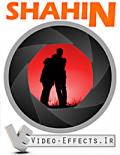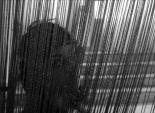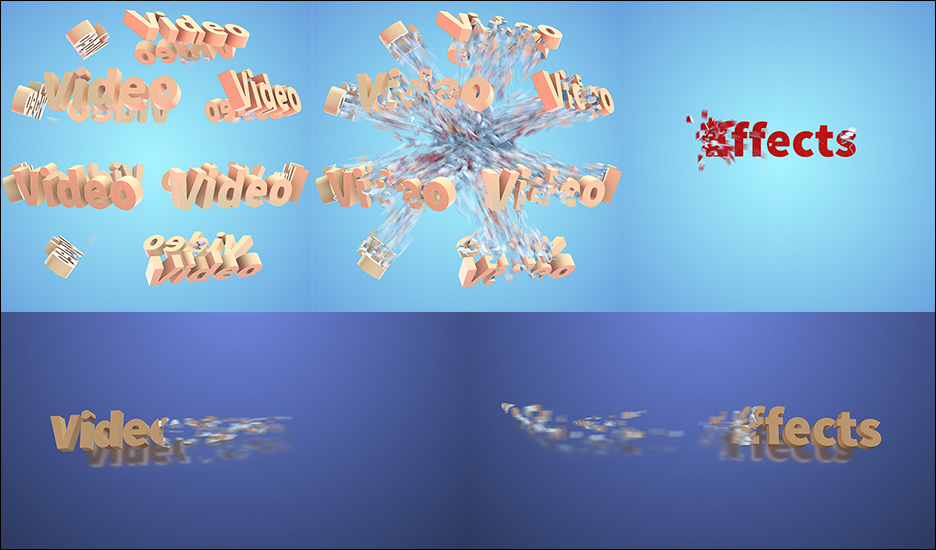خرد شدن یک نوشته در Element 3d افتر افکت
خیلی زیبا کار شده حتما ببینید
.
Download Source Files
Video Copilot’s new plug-in Element 3D let’s you create some great motion design like text dissolving into many small pieces. Unfortunately, fracturing has to be done before using Element 3D which usually means doing it in a 3D application. In this tutorial I would like to show you a technique of fracturing text for use with Video Copilot’s plug-in Element 3D without the need of using a 3D application.
Step 1
The first step is to open up Illustrator and prepare the text that we want to use in After Effects. In this tutorial we will use two sets of text: the first one consists of the Aetuts+ logo with an added subtitle, the second one reads "FRACTURED TEXT". Note that there is a lot of spacing between the lines and even between the letters A and E in the logo to make up for the space that we will later fill using the bevel in Element 3D.
Step 2
Duplicate each of the text groups so that you have two copies of each set. We will need two instances of each set: one "fractured" for the transition and a second "static" for when the text isn’t animated.
Step 3
Now comes the actual "fracturing" part. Select one of the groups and using the Knife tool cut it into pieces. Keep in mind that the more little pieces you create the more complex model you’ll create in Element so don’t overdo it. After you’ve finished with the first group re-apply the process for the second one.
Step 4
Next, we head into After Effects and setup our composition. For this tutorial we’ll use 1280×720, 23,976 fps and 10 second duration.
Step 5
It’s time to prepare our basic setup so create a new layer, name it "Element" and add one instance of Element from the Effects and Presets panel to it. Next, create a 24mm camera. Finally, we need to create some layers for our Illustrator paths so create four layers and name them: T1 (for the first "solid" set), T1_fractured (for the first "fractured" set), T2 (for the second "solid" set) and T2_fractured (for the second "fractured" set).
Step 6
Now we need to copy and paste our paths from Illustrator into After Effects. Go back to Illustrator and select the first "solid" set and copy it. Next, bring back After Effects, select the layer named T1 and paste. The paths should appear as a bunch of layer masks in After Effects. Repeat this process for each of the sets, both "solid" and "fractured". If you’re having a hard time seeing what you’re doing turn off the visibility for those of the layers that you’re not working on at the moment.
Step 7
It’s time to set up Element. First we need to assign the text paths to custom layers so open the Custom Layers and Custom Text and Masks drop downs and assign the text layers accordingly.
Step 8
Next we head into Element’s Scene Setup to extrude the text layers. Open the Scene Setup and click on Extrude. You should see the first text set. Don’t worry about it looking weird (notice that the letters E are not extruding correctly – we’ll deal with this later).
Step 9
Now we need to extrude the other layers. Click on the Extrude button three more times so that you have four Extrusion Models in total. Go into each one of them and change the Custom Path for each of them. The first one is okay but you need to change the Custom Path to Custom Path 2 for the second Model and so on for the rest.
Step 10
Reassign each of the Models to a different group. The first model should be in group one, the second in group two and so on. You can also rename the models by double clicking on the "Extrusion Model" field. For this tutorial I recommend you rename the models similar to the names we’ve given earlier to the solid layers. It’s easier this way to keep things organized.
Step 11
It’s beveling time. For this tutorial we’ll use a preset called "Racing". Go into the Material and Preset Browser and locate it in the Bevel presets. Drag it over each of the models. You’ll notice that the group assignment gets messed up and all the models get assigned to Group one. Fix this by reassigning them to proper groups like in the previous step.
Step 12
The next step is to change the color of the blue stripe for the first set of titles ("AETuts+ presents"). Click on the Glass_Tint material and scroll down the Edit window to the Illumination settings. Change the blue color to #AE00FF. Remember to do this for both T1 models (the "static" text and the "fractured" one).
Step 13
Now we need to fix all those extrusion glitches. This is a trial and error process so if you’re working with your own paths it takes a bit of patience and experimenting to see what fonts work and what can be "fixed" in Element. First, let’s concentrate on the T1 model. We need to fix the letters E in "Presents". In order to do this we need to uncheck the Separate Objects checkbox (don’t worry about it because we don’t need this model for it’s Multi Object options) and check the Fix Holes box.
Step 14
The T1_fractured seems okay as is so we’ll just leave it for now at the defaults settings and return to it once we begin animating. The T2 model needs a little work. Again, we need to fix some letters and we’ll do it this time by unchecking the Auto Path Orientation and checking the Reverse Path Winding and Fix Holes boxes.
Step 15
The last model to fix is the T2_fractured. We do this by setting the Spike Filter to 1.00. Close the scene setup for now by clicking OK.
Step 16
Now it’s time to fiddle with the animation. In order to do this we need to set up the Animation Engine but first let’s turn off any unnecessary layers. Go into Group 1 and Group 3 (those Groups are for the T1 and T2 model) and under Particle Look change the Force Opacity settings to 0%.
Step 17
Open up Group 2 and 4 (those Groups represent the "fractured" models) and under the Particle Look enable Multi-Object for both groups.
Step 18
Next, go to the Animation Engine settings and enable it. Then change the Start Group to Group 2 and Finish Group to Group 4. Set the Animation to 50% and you should see a transition happening but no flying chunks. For the purpose of this tutorial we’ll also set the Seed 11200 just for some randomness. It’s always a good idea to change the Seed from it’s default value to get some variation.
Step 19
We need to go back to the Scene Setup to make the "fractured" models break into smaller chunks. Go into the settings for both the T1_fractured and T2_fractured models and change the Separation Mode to By Geometry (Slow) and uncheck the Auto Path Orientation and close the Scene Setup by clicking OK. Now you should see some chunks in the animation.
Step 20
It’s time to setup the first animation which is the transition between the first set of titles to the second one. Go to the two seconds and one frame marker on the timeline and place a keyframe with 0% value for the Animation parameter. Next, go to the four seconds and one frame marker (timecode 0:00:04:01) and add a 100% keyframe. This should give you a transition between the two "fractured" sets.
Step 21
To add that circular movement to those little pieces you’ve seen in the example we go back to the Scene Setup and modify the T2 and T2_fractured models. In the Transform section for both models change
the second Orientation value to 180.0° – this will rotate the model. Click OK. You’ll notice that the model’s backside is facing the camera. To fix this twirl down the Rotation section in the Particle look for both the Group 3 and 4 and change the Y Rotation Particle to +180.0°. This results in the models facing the right side and also gives us that spinning movement in the animation.
Step 22
Now we can concentrate on making the chunks fly around in a less uniform fashion by animating the Size Random, Rotation Random and Scatter parameters in the Multi-Object section. For Group 2 set three
keyframes at the beginning of the animation: one for Size Random, another for Rotation Random and the final for Scatter Multi. Go to the end of the animation (four seconds mark) and set a keyframe Rotation Random with the value of 1x +0,0 and a keyframe with the value of 10,00 for the Multi-Scatter. For the Size Random go to the timecode of 0:00:03:01 (three seconds and one frame) and set a keyframe with the value of 100%.
Step 23
For Group 4 we need to do something similar but in reverse. Go to 0:00:02:16 and set a keyframe of 100% to the Size Random and a keyframe of +183.0° to the Rotation Random parameters. Next, go to
0:00:03:08 and set a 0 keyframe for the Rotation Random. Finally, set a 0 keyframe for Size Random at 0:00:03:15.
Step 24
The last thing to make the transition a bit more interesting is to change two settings in the Animation Engine. Open up the Direction Options and change the Yaw to 206.0° and the Pitch to 122.0°. Then in the Dual Animation Mode change the Type to Random. By now you should have a nice transition between both "fractured" sets. Now it’s a matter of showing the "solid" sets when the animation isn’t happening.
Step 25
What we need to do is animate the Opacity values between the "solid" and "fractured" sets just as the animation is starting and finishing. First let’s deal with the beginning of the animation. Go to the first frame of the animation (timecode 0:00:02:01) and set keyframes for the Force Opacity parameter for Groups 1 and 2: 0% for Group 1 and 100% for Group 2. Next, go back one frame by using the keyboard shortcut Cmd + Left arrow key and set a 100% Force Opacity for Group 1 and 0% for Group 2.
Step 26
We repeat the same process for the end of the animation. The only difference is that we need to show the "solid" set a bit earlier to fool the viewer’s eye. First, go to the last frame of the animation and set a keyframe for the Force Opacity at 0% for Group 4. Second, go back one frame and add another keyframe for Force Opacity of Group 4 this time make it 0%. Next, go to 0:00:03:22 and add a keyframe for Force Opacity for Group 3 with the value of 100%. Finally, go back one frame and add a 0% keyframe for Group 3′s Force Opacity parameter.
Step 27
To make the animation look better you can turn on Motion Blur for Element and the entire comp. However, for the purpose of this tutorial we will add a new Adjustment layer with a CC Force Motion Blur filter applied to it. The reason for this is that in my opinion it works better for this particular example. First, add a new Adjustment layer above the Element layer by pressing Cmd + Y and apply the CC Force Motion Blur filter to it. The default settings are okay. Next we need to adjust the beginning and end points for the Adjustment layer so that the blur is only visible when the animation is happening (if the blur is visible during the Opacity transition you’ll get a weird look so keep that in mind). Set the beginning point of the Adjustment layer at the start of animation (keyboard shortcut Option + {) and set the end point right after Group 3 gets a 100% Opacity (timecode 0:00:03:23).
Step 28
Having dealt with the first transition let’s move on to the second one which is the second set of titles dissolving into little pieces and disappearing as they fly away. Once again we will utilize the Animation Engine but this time instead of transitioning between two sets of particles we’ll just transition a full Group 4 into an empty Group 5 – this is a good way to bring in/out particles into your scene. Once, again we’ll use the opacity trick to show the "fractured" set once the animation begins but first we need to make some changes in the Animation Engine. We want the second animation to start at eight seconds and one frame so we need to adjust some settings earlier in time. Go to 0:00:07:15 and add the following keyframes:
- Force Opacity for Group 2 at 100% (we will need to hide Group 2 because the Animation Engine will no longer affect it)
- Start Group keyframe in the Animation Engine Group Selection for Group 2
- Finish Group keyframe for Group 4
Step 29
Go forward one frame and change the Force Opacity for Group 2 to 0%, Start Group from Group 2 to Group 4 and set the Finish Group to Group 5.
Step 30
The only other thing we need to reset in the Animation Engine is the Animation parameter. Go to 0:00:07:23 and set a keyframe (it should be at 100%) and then go forward one frame and add another keyframe this time with the value of 0%. Finally go to the end of the composition (ten seconds marker) and set a keyframe for Animation with the value of 100%. This takes care of the Animation Engine.
Step 31
Next, we need to hide the "solid" set and show the "fractured" one once the animation is starting. Like before we’ll use the Force Opacity parameter for Groups 3 and 4. Go to 0:00:08:00 and set keyframes for Force Opacity for Group 3 and Group 4 (they should be at 100% and 0% respectively). Next, go one frame forward and change Group 3′s Force Opacity to 0% and Group 4′s to 100%. You should see a similar effect to the one we achieved in step 25.
Step 32
It’s time to add some more movement to the particles. Having your time marker placed at 0:00:08:01 set the following 0 value keyframes:
- Size Random
- Rotation Random
- Scatter Multi
Step 33
Go to 0:00:08:16 and set a 100% keyframe for Size Random and +180.0° keyframe for Rotation Random. Then go to 0:00:09:16 and set the Scatter Multi to 4.34.
Step 34
Now we’ll add a bit more spin to the movement and also drag the flying pieces down to imitate a falling motion. We do this by playing around with Group 5′s settings. Since the group is empty and serves only as a transition tool you can go crazy. For the purpose of this tutorial we’ll use the Group’s Y position and X rotation values. First, go to the eight seconds marker and place a keyframe for the Position XY in the Particle Replicator Settings. Next, go to 0:00:08:05 and set a keyframe for the X Rotation. Third, go to the nine seconds mark and add another keyframe for the X Rotation this time with the value of +159.0°. Finally, go to 0:00:09:16 and set the Y position in the Position XY value to 592.0. Basically, what’s happening is that while the animation progresses the particles move down and get additional rotation from those settings.
Step 35
The last thing to do with the animation is to add some motion blur. For the purpose of this tutorial we’re using an Adjustment layer with CC Force Motion Blur (see Step 27) so we can just duplicate that layer (keyboard shortcut Cmd + D) and place it accordingly. Just remember to start the Adjustment layer no sooner then the Opacity transition between the groups completes.
Step 36
It’s time to add a background, camera move and some lights to the scene. First, let’s tackle the background. Add a new Solid and fill it with #643712, rename it to "bg" and place it underneath the Element layer. Then, add another Solid this time make it white, rename it to "spot", place it above the bg layer and change it’s Blending mode to Add. Having the "spot" layer selected take the Ellipse tool and double click on it. This will add an elliptical mask to this layer. Change the mask’s feather settings to 213.0. Finally drop down this layer’s Opacity to 52%. This creates a nice hot spot with some vignetting around the edges.
Step 37
Next, we add a basic three light setup which will help us add some Glow later. In this tutorial we’ll be using Spot lights but it’s up to you to experiment with various types of lights and their settings especially try out different light placement and see how it influences the look of the scene. First, let’s create a Key light with the color value of #F7E7CD you can see the rest of the settings in the screenshot below.
Step 38
Second, let’s add a Rim light with the color value of #CDEFF7. See the rest of the setting in the screenshot below.
Step 39
Finally, we add an Overhead light. Set its color to #F7ECCD and the rest of the parameters like in the screenshot.
Step 40
Now let’s animate the camera. Basically we want it to orbit around the two sets of titles with some zooming. For the second animation (the second set’s dissolve) we want to move camera above the flying pieces to add some more variation to the chunks’ movement. See the below screenshots for detailed keyframe settings.
Step 41
Let’s get back to the Element layer and add some Ambient Occlusion and Glow. First, open up the Render Settings section of Element and in the Ambient Occlusion (SSAO) check Enable AO. Second, open up the Glow section and do the following:
- Check Enable Glow
- Set Glow From to Luminance
- Change Glow Threshold to 0,80
- Set the Glow Tint color to #FFAD37 Finally go to the Output module and in the Sampling & Aliasing set the Supersampling to 2 to get rid of any jagged edges you might get.
Step 42
The last thing to do is to add some color correction. Add a new Adjustment layer, change its name to "cc" (for color correction) and add a Curves adjustment to it. For the purpose of this tutorial use the settings from the screenshot.
Step 43
At this point I decided to add another curves adjustment to the same layer with the following settings.
The End














































 پاسخ با نقل قول
پاسخ با نقل قول






